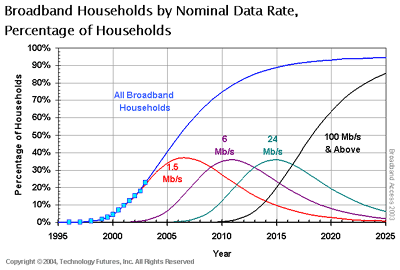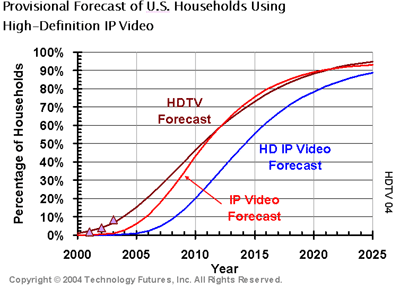According to a report by Technology Futures Inc. (TFI), by 2006, one-half of U.S. households will subscribe to broadband access, and a shift to much higher data rates in the range of 24 Mb/s to 100 Mb/s will have begun. By 2010, U.S. broadband penetration of 75% is likely, and 10% to 20% of U.S. households will subscribe to very high-speed-broadband. In the process, most of the local exchange carriers current investment in copper cable will be made obsolete.
The study, "Forecasts for Higher Bandwidth Broadband Services," authored by Lawrence K. Vanston, Ph.D. (President, TFI), forecasts how bandwidth requirements will increase over time and addresses the applications requiring higher speed. In doing so, it reviews what is happening in South Korea (where broadband penetration already exceeds 70%), Japan, and Italy--current leaders in the migration to higher data rates.
Key findings of the report are listed below.
The research was sponsored by the Telecommunications Technology Forecasting Group (TTFG), a consortium of telephone companies comprised of Bell Canada, BellSouth Telecommunications, Qwest, SBC, Sprint, and Verizon.
According to Dr. Vanston, "Our forecasts for higher bandwidths reflect the general tendency for bandwidth demand to increase along with computing power and memory. They also reflect the demand for specific services such as IP video that require more bandwidth.

The upper curve shows TFI's forecast for broadband penetration in general. The bell-shaped curves show successive broadband generations broadband, each characterized by a higher nominal data rate. These curves reflect the general tendency for bandwidth demand to increase along with computing power and memory. An important transition begins in 2006 with the 24 Mb/s generation, which will require fiber optics to, or close to, the home.
TFI forecasts that 40% of U.S. households will use IP video in 2010 and 20% will demand high definition IP video."

IP video is an application that requires more bandwidth than generally available on residential broadband today. TFI forecasts that over 40% of U.S. households will use IP video in 2010. As HDTV becomes prevalent, consumers will want to access HD IP video. Combining the IP video forecast and an HDTV forecast provides a forecast of HD IP video. According to this forecast, about 5% of households will use HD IP video by 2007 and 20% by 2010.
Key Findings From TFI Report:
Broadband will eventually be adopted by most households as websites become increasingly designed for broadband, e-mail attachments (e.g., photo collections) grow large, and new services such as VoIP become widely adopted.
U.S. residential broadband will soon demand higher data rates than currently provided, probably in the range of 6-10 Mb/s, which is already available in leading broadband countries.
In the 2006 timeframe, a shift to much higher data rates in the range of 24 Mb/s to 100 Mb/s is likely to begin. So far, only a few places have access at these rates, notably Japan.
Leading broadband countries are a full generation ahead of North America. Japan and Korea are already rolling out the subsequent generation of services operating at 20 Mb/s and above, and have plans to complete the transition by 2010.
There are factors that favored early broadband adoption and rapid broadband progress in the leading countries. However, there is nothing unique about these countries in their need for broadband and faster rates and nothing that indefinitely precludes North America from having it available.
The results confirm TFI's scenarios for the placement of fiber optics deep into ILEC networks, extending to the home via BPONs, or very close to the home via VDSL technology. In the process, much of ILEC current investment in metallic cable will be made obsolete.
This report would be of interest to:
- Incumbent local exchange carriers
- Competitive LECs
- Interexchange carriers
- Internet service providers
- Telecom equipment manufacturers
- Regulatory personnel
- Depreciation professionals
|
Author Lawrence K. Vanston, Ph.D., http://www.tfi.com/staff/bios/vanstonl.html, is an internationally- recognized authority in the use of technology forecasting in the telecom industry. His research reports and forecasts are used and referenced extensively worldwide. Dr. Vanston's views on telecom trends have also been cited in many major publications including "The Wall Street Journal," "Telephony," "America's Network," and "Lightwave."
For 25 years, TFI has helped organizations plan for the future by offering outstanding technology forecasting, strategic planning, trend analysis, and strategic market research services in high-technology and telecom technologies. Drawing on proven, quantifiable forecasting methods and strategic applications, we combine the vision of the futurist with the down-to-earth judgment of the technologist. Let us be "Your Bridge to the Future."
PURCHASING INFORMATION: Report details and ordering information is available at http://www.tfi.com/pubs/r/r02004_broadband.html.Readers interested in purchasing a copy may also contact Debra Robison, Technology Futures, Inc. at (800) TEK-FUTR or (512) 258-8898, fax (512) 258-0087, or send email to [email protected].
Technology Futures, Inc.
13740 Research Boulevard, Building C
Austin, TX 78750
(800) 835-3887 or (512) 258-8898
Fax: (512) 258-0087
www.tfi.com
|
|